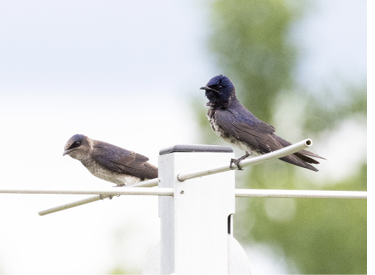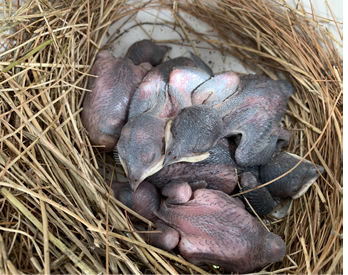Mary C. McKitrick

The successful nesting pair at the Fort River USFWS in Hadley, MA, 2024. All photographs by the author.

Five Purple Martin nestlings, July 13, 2024.
In 2021, Andrew French, refuge manager at the Silvio O. Conte National Fish and Wildlife Refuge, put up a set of 12 nesting gourds for Purple Martins (Progne subis) at the Fort River branch in Hadley. A number of us in the birding community were puzzled, because we do not routinely get Purple Martins in Hampshire County. Veit and Petersen (1993) noted that cold rains in the summer of 1903 wiped out the swallow populations throughout Massachusetts, and although the smaller species recovered, martins did not. Bagg and Eliot (1937) summarized anecdotal records of Purple Martins in Hampshire and surrounding counties. They cited an observer stating that martins were “once very common in Amherst but now comparatively rare.” They are established locally at several sites in the eastern part of the state from Plum Island to Cape Cod, but no nesting records for Hampshire County exist on eBird (<http://www.ebird.org>, accessed 18 Feb 2025). We thought the endeavor at Fort River was doomed.
When several martins appeared that spring, we were excited and prepared to eat crow, but there was no evidence that they nested. The next year, the gourds were taken over by House Sparrows (Passer domesticus) and Tree Swallows (Tachycineta bicolor), and any martins that visited were aggressively excluded. In 2023, Theresa Gessing and I wrote a proposal to the U.S. Fish and Wildlife Service to take over the management of the gourds. We planned to take the gourds down for the winter, clean them, plug them and store them on site, and put them up in the spring when the first martin scouts arrived. Two volunteers from Hampshire Bird Club—Jim Lafley and George Regmund—made three Tree Swallow nest boxes for us and installed them near the gourd site, and the Fish and Wildlife Service gave us a fourth box. The boxes were installed in March 2024 and we put the gourds back up, still plugged, in April.
To view the rest of the article you'll need to
subscribe. Bird Observer publishes original articles on birding locations, on avian populations and natural history, on regional rarities, field notes, field records, photographs, and art work.